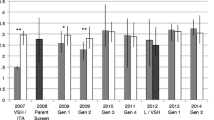Abstract
A laboratory bioassay was used to study phenotypic differences in susceptibility of honey bees,Apis mellifera L., to tracheal mites,Acarapis woodi Rennie. Significantly different infestation frequencies were found in bees from 23 colonies containing queens that were instrumentally inseminated with single drones. Queens and drones originated from a closed population composed of commercial stock from various areas of the United States.
Mites were randomly distributed with respect to right and left prothoracic tracheae. Tracheae containing mites were no more or less attractive to migrating mites than non-infested tracheae. The same quantity of progeny per female was produced in tracheae containing 1–3 mites. Female mites apparently do not migrate a second time after egg laying begins.
The degree of phenotypic variation suggests that selection of honey bees for tracheal mite resistance is feasible.
Similar content being viewed by others
References
Bailey, L., 1958. The epidemiology of the infestation of the honeybee,Apis mellifera L., by the miteAcarapis woodi Rennie and the mortality of infested bees. Parasitology, 48: 493–506.
Bailey, L., 1981. Honey Bee Pathology. Academic Press, New York, 124 pp.
Delfinado-Baker, M., 1984.Acarapis woodi in the United States. Am. Bee J., 124: 805–806.
Dhaliwal, H.S., Srivastava, S. and Sharma, P.L., 1974. Some biological observations on the mite,Acarapis woodi Rennie, infesting honeybees,Apis cerana indica F. Curr. Sci., 43 (23):750–751.
Gary, N.E. and Lorenzen, K., 1987. Vacuum device for collecting and dispensing honey bees (Hymenoptera: Apidae) into cages. Ann. Entomol. Soc. Am. (in press).
Giordani, G., 1977. Facts about Acarine mites. Proc. XXVIth Int. Congr. Apicult., 459–467.
Laidlaw, H.H., 1977. Instrumental insemination of honey bee queens. Dadant & Sons, Hamilton, Ill., 144 pp.
Laidlaw, H.H., 1979. Contemporary queen rearing. Dadant & Sons, Hamilton, Ill., 199 pp.
Lee, D.C., 1963. The susceptibility of honey bees of different ages to infestation byAcarapis woodi (Rennie). J. Insect Pathol., 5: 11–15.
Lorenzen, K. and Gary, N.E., 1986. Modified dissection technique for diagnosis of tracheal mites (Acari: Tarsonemidae) in honey bees (Hymenoptera: Apidae). J. Econ. Entomol., 79 (5): 1401–1403.
Mackensen, O. and Tucker, K.W., 1970. Instrumental insemination of queen bees. U.S.D.A. Handb. No. 390, 28 pp.
Morgenthaler, O., 1929. Problems of Acarine disease of bees. Bee World, 10: 19–24.
Morgenthaler, O., 1930. New investigations on Acarine disease. Bee World, 15 (5): 49–50.
Morgenthaler, O., 1931. An Acarine disease experimental apiary in the Bernese Lake District and some of the results obtained there. Bee World, 12 (1): 8–10.
Morgenthaler, O., 1932. Ein Jahrzehnt Milbenkrankheit der Honigbiene. Entdeckung, Erforschung und Bekampfung eines Seuchen-Erregers. Z. Angew. Entomol., 19: 449–489.
Morison, G.D., Jeffree, E.P., Murray, L. and Allen, M.D., 1956. Acarine andNosema diseases of honeybees in Britain, 1925–1947. Bull. Entomol. Res., 46 (4): 753–759.
Page, R.E., Erickson, E.H. and Laidlaw, H.H., 1982. A closed population breeding program for honey bees. Am. Bee J., 122(5): 350–351, 354–355.
Robinson, F.A., Thel, K.L., Littell, R.C. and Linda, S.B., 1986. Sampling apiaries for honey bee tracheal mite (Acarapis woodi Rennie): Effects of bee age and colony infestation. Am. Bee J., 126: 193–195.
Ruttner, F., 1976. The instrumental insemination of the queen bee. Int. Beekeep. Tech. Econ. Inst. Apimondia, Bucharest, Romania, 124 pp.
Severson, D.W., Page, R.E. and Erickson, E.H., 1986. Closed population breeding in honey bees: A report on its practical application. Am. Bee J., 126: 93–94.
Sokal, R.R. and Rohlf, F.J., 1969. Biometry. W.H. Freeman, New York, 776 pp.
Author information
Authors and Affiliations
Rights and permissions
About this article
Cite this article
Gary, N.E., Page, R.E. Phenotypic variation in susceptibility of honey bees,Apis mellifera, to infestation by tracheal mites,Acarapis woodi . Exp Appl Acarol 3, 291–305 (1987). https://doi.org/10.1007/BF01193166
Accepted:
Issue Date:
DOI: https://doi.org/10.1007/BF01193166




